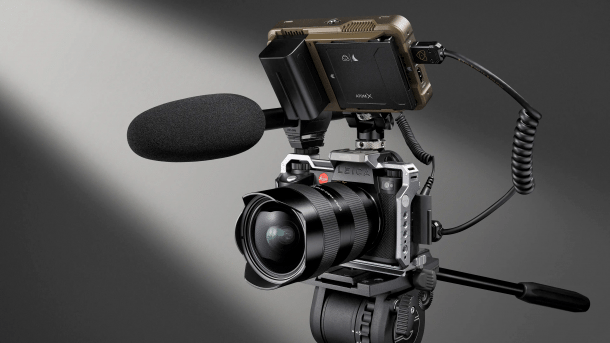Photo news: Sandisk's SD failure and new Leica with CAI
Three SD cards from Sandisk produce broken images with an R5 II, and Leica's new SL focuses on video and tamper-proof images.

A Leica for filming too? Yes, according to the manufacturer itself.
(Image: Leica)
A digital device must not do two things: It must not miscalculate – best regards to Intel – and it must not lose data. Sandisk, a company that has been known as a storage specialist for a good two decades, has now done both. If you insert one of three SD cards from the UHS II series with the "V60" suffix for video recording speed into Canon's R5 II, the images may be unusable.
It therefore appears that the logic in the SD card is miscalculating and thus corrupting data. Under what conditions this occurs, what the actual problem is, the so-called "root cause" – all unclear. The little that the two companies have managed to elicit can be found in a recent report. As detailed as possible, so here it is in a nutshell: The V60 cards with UHS-II, and only these, in the sizes 64, 128 and 256 GByte are affected. The newer and faster V90 cards are not affected, nor are the V60 cards with 512 GB or 1 TByte.
For the professional model of all things
Sandisk wants to replace the cuttings, but that is little consolation if you have ever had the problem. Broken pictures are broken pictures, some of them irretrievable. It is particularly strange that such an error occurs with a professional device such as the R5 II, which has been in development for years and did not simply fall from the sky. Since the fault is obviously in the memory cards, perhaps they should no longer be trusted in other devices either. It would be urgently necessary for Sandisk to comment on the root cause.
Videos by heise
However, this is hardly to be hoped for, as Sandisk has already largely sat out a issue with masses of failing SSDs from the Extreme (Pro) Portable series in 2023. Instead, the devices were available at large discounts from many retailers for months, and third parties pointed to the root of the problem: bad solder joints. The company's reputation is now so tarnished in professional circles that Petapixel even advises people not to buy Sandisk devices at all. You have to achieve that with a brand once known for reliability in just a few years. Western Digital only bought Sandisk in 2015, and since then the problems have been piling up – The company is of course keeping the exact connection to itself.
Leica SL3-S for press and video
Things are currently going much smoother for Leica. They are presenting one camera after the other, which, although they have the well-known high prices, also have something special to offer technically in addition to the brand image. In the case of the new SL3-S, this is above all the support for forgery-proof images in accordance with the CAI standard initiated by Adobe. With only 24 megapixels in full format compared to the 60 of the SL3, the focus is also more on speed, which is often needed for press photos. The SL3-S is said to be capable of 30 images with full autofocus, and we also have a really detailed report on it.
So let's just focus on what can be squeezed out of "only" 24 megapixels if the rest of the hardware and software are optimized accordingly. This includes ProRes video with 4:2:2 sampling and 5.8K resolution for internal recording without a time limit. Or save 5.9K resolution as raw video on an external USB-C SSD. Allow me to digress: perhaps not on a Sandisk Extreme Pro.
Almost inexpensive for a Leica in comparison
As with many other current cameras, Leica videos – yes, even upright – are now just as important as taking photos. And, perhaps a shock for fans of the brand: it's not even that expensive. At 5200 euros, it is even significantly cheaper than the sports and press flagships from Sony and Canon. Their Alpha 1, R9 III and R1 are priced at over 7000 euros. In terms of price, Leica's closest competitor here is Nikon's Z9, which is available for around 5000 euros. But with its fixed vertical grip and many more special functions and connections, it is a professional camera and not very elegant. And the latter is what Leica is all about.
What photographers want – and how they can get it
As we are once again talking a lot about professionals in this issue of our column, we simply asked our readers – – what they really expect from modern camera technology. The result was"The perfect camera: what professionals really need". This is not just a list of wishes, but a clever analysis with concrete suggestions for solutions, also directed at the camera manufacturers. This is not wishful thinking, because as Sandra Petrowitz writes: "It won't do much good to put a bow on these and other wish lists and send them to Japan. But firstly, we know that many camera manufacturer employees are among our regular readers, and we hope that one or two ideas will miraculously work their way through the hierarchies to the company headquarters." Naturally, this piece is our recommendation for a long read over the weekend.
(nie)